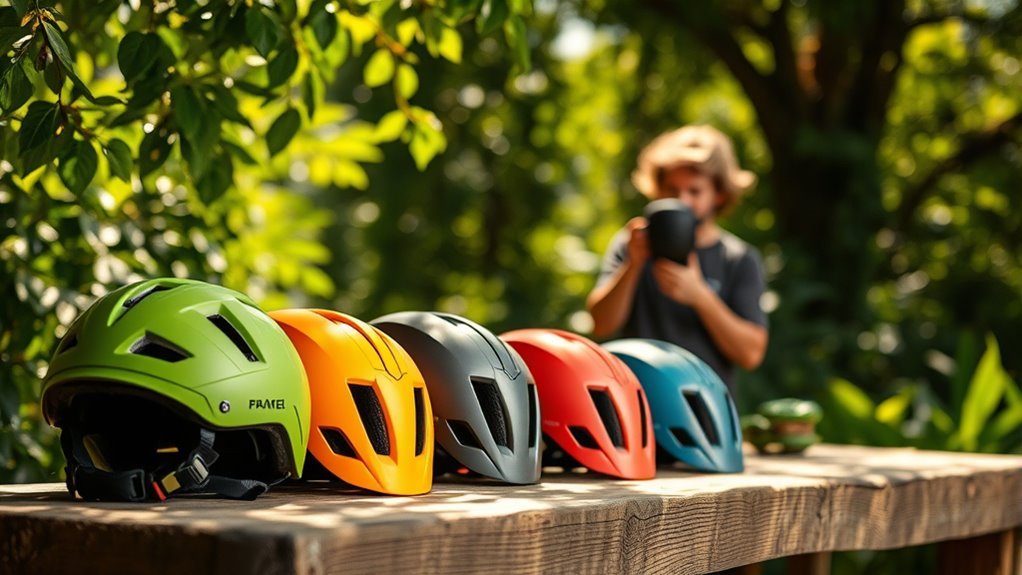How to Choose an Eco-Conscious Helmet Brand
When choosing an eco-conscious helmet brand, evaluate materials for eco-friendliness and recyclability. Check brand transparency regarding sustainable manufacturing practices and certifications that guarantee safety and environmental compliance. Look for companies that prioritize ethical labor and use biodegradable packaging. Customer reviews can provide insights into the brand’s reputation and commitment to sustainability. Balancing price and long-term value is essential. By considering these factors, you’ll position yourself to make a responsible choice for the environment. More insights await you.
Understanding Eco-Conscious Materials

When you’re choosing an eco-conscious helmet brand, it’s essential to understand the materials that make up these products, as they directly influence both safety and sustainability. Look for helmets crafted from eco-friendly fabrics derived from renewable resources; these materials not only reduce environmental impact but also guarantee durability and comfort. For instance, biodegradable composites and recycled plastics can offer robust protection while minimizing waste. By selecting a helmet made from such materials, you’re not just prioritizing your safety; you’re also supporting a market that values ecological responsibility. Choosing wisely empowers you to embrace freedom on your rides, knowing you’re making a positive difference. So, consider the material choices carefully, and ride with confidence in your eco-conscious decision.
Evaluating Sustainable Manufacturing Processes

Selecting an eco-conscious helmet brand goes beyond just the materials; it also involves scrutinizing the manufacturing processes that produce these helmets. You should look for brands that utilize sustainable technologies, which minimize waste and energy consumption. Investigate how the helmets are made—are they produced in facilities that prioritize ethical labor? Supporting companies that guarantee fair wages and safe working conditions not only aligns with your values but also promotes a more just economy. By opting for brands committed to transparency in their manufacturing processes, you’re empowering yourself and others to make responsible choices. Remember, choosing a helmet isn’t just about safety; it’s about endorsing a lifestyle that respects both the planet and its people.
Importance of Certifications and Standards

When choosing an eco-conscious helmet, it’s vital to take into account recognized safety certifications and environmental standards compliance. These certifications not only guarantee your helmet meets essential safety requirements but also reflect the brand’s commitment to sustainable practices. By prioritizing these factors, you’re making a more informed choice that balances safety and environmental responsibility.
Recognized Safety Certifications
Although many factors influence your choice of an eco-conscious helmet brand, recognized safety certifications are essential for guaranteeing that the product meets established safety standards. Certifications provide reassurance that the helmet can protect you effectively while riding. Here are three key certification types to look for:
- CPSC: Guarantees helmets meet U.S. safety standards for bicycle riders.
- ASTM: Covers various sports helmets, including those for skateboarding and snow sports.
- Snell: Offers rigorous testing for high-performance helmets, especially in motorsports.
Environmental Standards Compliance
While safety certifications are essential for ensuring a helmet’s protective capabilities, environmental standards compliance is equally important in choosing an eco-conscious brand. You want a helmet that not only protects your head but also respects the planet. Look for compliance certifications that showcase adherence to strict environmental regulations, ensuring that the materials and processes used are sustainable. Brands that prioritize environmental standards demonstrate a commitment to reducing their ecological footprint, which aligns with your values of freedom and responsibility. By choosing a helmet with robust environmental compliance, you’re not just making a purchase; you’re supporting a movement toward a more sustainable future. So, take the time to research and select a brand that genuinely cares about our planet.
Assessing the Brand’s Environmental Commitment
When evaluating a helmet brand’s environmental commitment, look closely at their sustainability practices and how they source materials. Brands that prioritize transparency in their supply chain often reflect a genuine dedication to eco-friendly initiatives. By understanding these factors, you can make a more informed choice that aligns with your values.
Sustainability Practices Overview
As you evaluate eco-conscious helmet brands, it’s crucial to scrutinize their sustainability practices, since a brand’s environmental commitment often reflects its overall ethos. Look for indicators of responsible behavior that showcase their dedication to sustainable innovation trends and eco-friendly technologies. Consider the following:
- Production Processes: Are they using renewable energy sources or minimizing waste during manufacturing?
- Lifecycle Management: Does the brand promote recycling programs or take-back initiatives for old helmets?
- Certifications: Are they certified by recognized environmental organizations, proving their commitment to sustainability?
Materials Sourcing Transparency
Understanding a brand’s materials sourcing transparency is essential, especially since it reveals how committed they are to environmental responsibility. When you’re looking for an eco-conscious helmet, assess how openly a brand discusses their material sourcing. Do they provide detailed information about where their materials come from and how they’re produced? Brands that prioritize ethics often share this information, showcasing their dedication to sustainable practices. By choosing a brand that values transparency, you align your purchase with your desire for freedom—freedom from guilt about environmental impact. So, dig deeper into their sourcing practices; it’s not just about the helmet, but the values behind it. Your choice reflects your commitment to a healthier planet and supports brands that prioritize ethical material sourcing.
Exploring Recyclable and Biodegradable Options
While many helmet brands focus on safety and style, an increasing number are prioritizing sustainability by offering recyclable and biodegradable options. Choosing these helmets allows you to enjoy your freedom while making a positive impact on the environment. Consider these factors when exploring your options:
- Recyclable Materials: Look for helmets made from materials that can be easily recycled, minimizing waste and reducing your environmental footprint.
- Biodegradable Options: Seek out brands using biodegradable components that break down naturally, ensuring your helmet won’t linger in landfills for centuries.
- End-of-Life Programs: Some companies offer take-back programs to recycle helmets responsibly when they reach the end of their life.
Considering Local vs. Global Production
How do the origins of your helmet impact its sustainability? Choosing between local and global production can greatly influence your eco-conscious decision. When you support local artisans, you’re often backing sustainable practices that prioritize reduced carbon footprints and community welfare. Local production typically means shorter shipping distances, which cuts down on environmental impact. On the other hand, global supply chains can exploit resources and labor, leading to questionable sustainability practices. By opting for helmets made by local artisans, you not only foster regional economies but also guarantee a commitment to responsible craftsmanship. In a world where freedom to choose aligns with environmental stewardship, think carefully about where your helmet comes from—it matters more than you might realize.
Analyzing the Brand’s Supply Chain Transparency
When evaluating an eco-conscious helmet brand, transparency in its supply chain is essential to making informed decisions about sustainability. You want to guarantee that the company practices strong supply chain ethics and demonstrates brand accountability. Here are three key aspects to take into account:
- Material Sources: Look for brands that disclose where they source their materials. This can indicate their commitment to sustainable practices.
- Manufacturing Process: Investigate how the helmets are made. Ethical labor practices and environmentally friendly methods are critical.
- Traceability: A transparent supply chain allows you to trace each component’s origin. This level of detail shows a brand’s dedication to ethical practices.
Investigating the Use of Eco-Friendly Packaging
What role does packaging play in the overall sustainability of an eco-conscious helmet brand? It’s vital. When you choose a helmet, consider how it’s packaged. Brands using eco-friendly materials not only reduce waste but also minimize their carbon footprint. Look for companies that prioritize biodegradable or recyclable packaging, as this reflects their commitment to sustainability. Additionally, consider their approach to sustainable shipping. Efficient logistics can cut emissions, making a significant difference in a product’s overall environmental impact. By supporting brands that embrace these practices, you’re not just buying a helmet; you’re contributing to a larger movement for a greener planet. So, keep an eye out for those eco-friendly packaging choices—they matter more than you might think.
Reading Customer Reviews and Brand Reputation
Why should you pay attention to customer reviews and brand reputation when choosing an eco-conscious helmet? The insights you gain can guide you toward brands that truly align with your values. Here’s why customer feedback is vital:
- Quality Assurance: Positive reviews often indicate that a brand consistently delivers on quality, ensuring your safety while riding.
- Sustainability Practices: Customers frequently share their experiences with a brand’s eco-friendly initiatives, helping you make informed choices.
- Brand Loyalty: Brands with strong reputations tend to foster customer loyalty, suggesting that they prioritize ethical practices in their production.
Balancing Price and Sustainability Factors
How can you strike the right balance between price and sustainability when choosing an eco-conscious helmet? Start by conducting price comparisons across various brands that prioritize eco-friendly materials and production methods. While a lower price might seem appealing, consider the long-term value assessment of your investment. Are you supporting a brand that contributes to environmental well-being? A more expensive helmet could offer better durability and safety features, ultimately saving you money in the long run. Look for certifications or eco-labels that indicate a commitment to sustainable practices. By weighing these factors, you can find a helmet that not only fits your budget but also aligns with your values, allowing you to ride freely with peace of mind.
Frequently Asked Questions
How Can I Verify a Brand’s Eco-Friendly Claims?
Did you know that 73% of consumers are willing to pay extra for sustainable products? To verify a brand’s eco-friendly claims, look for sustainability certifications like Fair Trade or Cradle to Cradle. Check the brand’s transparency; they should openly share their sourcing and manufacturing processes. By doing your research, you empower yourself to make informed choices that align with your values, ensuring your purchases contribute to a healthier planet while enjoying your freedom.
Are There Specific Eco-Labels I Should Look for on Helmets?
When choosing a helmet, look for eco-labels like GreenGuard or Cradle to Cradle, which signify adherence to eco-friendly practices. These labels reflect the brand’s commitment to sustainability and responsible materials. Additionally, check for helmet certification standards like CPSC or EN 1078, ensuring safety alongside eco-consciousness. By prioritizing these labels, you’re not just protecting your head; you’re supporting brands that care about the planet, giving you the freedom to ride responsibly.
What Are the Environmental Impacts of Traditional Helmet Materials?
Traditional helmet materials, like polystyrene and polycarbonate, can linger in landfills for centuries, creating a stark contrast to the lush greenery you cherish. These non-biodegradable options contribute to pollution and waste. Imagine instead a helmet made from sustainable materials, designed to break down naturally over time. By choosing biodegradable options, you not only protect your head but also the planet, ensuring future generations can enjoy the freedom of the outdoors without the burden of waste.
How Do I Properly Recycle an Old Helmet?
To properly recycle an old helmet, first check for local recycling options that accept such materials. Many municipalities have specific guidelines for helmet disposal, often directing you to specialized programs. If recycling isn’t available, consider donating it to organizations that promote safety gear reuse. By responsibly disposing of your helmet, you’re contributing to a more sustainable future, ensuring that materials are repurposed rather than ending up in a landfill.
Can Eco-Conscious Helmets Provide the Same Safety as Traditional Ones?
Yes, eco-conscious helmets can meet the same safety standards as traditional ones. They undergo rigorous helmet testing to guarantee impact protection and durability. You might wonder if sustainable materials compromise safety, but many brands prioritize both environmental responsibility and performance. By choosing an eco-friendly option, you’re not just safeguarding your head; you’re also making a statement for freedom—freedom to protect the planet while enjoying your ride. So, why not embrace both safety and sustainability?






